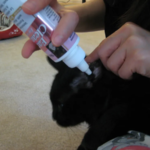Most people have heard of ear mites and know they are a common ear parasite of dogs and cats. Unfortunately, this common knowledge frequently leads to the assumption that a pet’s inflamed ear is due to an ear mite infection, when in fact a much more common bacterial or yeast infection is afoot. This can lead to weeks of inappropriate treatment with over the counter ear mite preparations. Even if ear mites are actually present, there have been tremendous advances in treatment such that weeks of oily ear cleanings have been supplanted by single-use products. This FAQ should help explain the facts of ear mite infection, biology of the mite, and treatment choices and pitfalls.
What are Ear Mites?
Ear mites are tiny infectious organisms resembling microscopic ticks. The mite can just barely be seen as a small white dot with the naked eye, but usually must be detected by examining a sample of ear wax under a microscope. Infection usually produces a characteristic dry black ear discharge that is commonly said to resemble coffee grounds. This discharge is composed of ear wax, blood, inflammatory biochemicals, and the ear mites themselves. Because the discharge is so classic in appearance, a diagnosis of ear mite infection is often made based on its presence. This leads to the potential to be led astray. It is best to examine the material under the microscope and confirm the mites so that proper treatment can be instituted.
The Bizarre Ear Mite Life Cycle
The mite lives on the surface of the ear canal skin, though sometimes migrates out onto the face and head of its host. Eggs are laid and hatch after 4 days of incubation. The larva hatches from the egg, feeds on ear wax and skin oils for about a week and then molts into a protonymph, which in turn molts into a deutonymph. The deutonymph mates with the adult male. What seems especially bizarre to us mammals is that the deutonymph has not yet developed a gender at the time it mates with the adult male.
After mating, the deutonymph molts into either an adult male or an adult female. If it becomes a female, she will be gravid with eggs as a result of the mating. If it develops into a male, there are no consequences to the mating and he is ready to mate with deutonymphs of his own choosing. The adult mite lives approximately two months happily eating ear wax and skin oils. The life cycle – the time it takes for an egg to develop into an adult mite ready for parenthood – requires three weeks.
Most ear mite cases are found in cats. Dogs can be infected as well but, since dogs more commonly get ear infections of other types, ear infections in dogs usually do not involve mites.
How did my Pet get Ear Mites?
Ear mites readily transmit from host to host by physical contact. Ear mites came from some other animal with which your pet was socializing. Because mites are easily transmissible by physical contact, treatment for mites often must include all household pets.
What Harm Comes from Ear Mite Infection?
Ear mites are inflammatory and they can generate very irritating ear infections. Skin disease can also result from ear mite infection.
Is this Contagious to Me?
Ear mite infection is certainly contagious among cats and dogs. Typically, the victim is an outdoor cat. Humans have been reported to develop skin rashes rarely; in general, we may consider that a human is extremely unlikely to experience any symptoms when their pet is infected with ear mites.
How do I Get Rid of Ear Mites?
Topical Treatments: At Least Three Weeks Usage
There are numerous products available for ear mite eradication. Most older and over-the-counter products contain insecticides that do not kill incubating mite eggs. Because of this limitation, such products must be used for at least the duration of the 21-day life cycle. Some specialists recommend a 30-day treatment course with such products. While these products do work and are readily available at most pet supply stores, three weeks of use is relatively inconvenient and the pet may not always be cooperative.
Topical Treatments: At Least Ten Days Usage
Another approach involves the use of a prescription topical ear medication called Tresaderm® that contains an antibiotic for any secondary bacterial infections, a cortisone derivative for the inflammation, and thiabendazole to kill yeasts and mites. This is an excellent ear product and is able to kill the developing mite eggs. This cuts the treatment course down to 10 to 14 days and provides an excellent oily lubricant with which to clean the ears. This product has been favored by veterinarians for decades; still, it is no longer state of the art.
Injection: Two to Four Treatments
A newer treatment, which is not FDA-approved, involves the use of ivermectin, a powerful anti-parasite medication. Ivermectin is especially helpful for pets who will not allow direct treatment of their ears. Most ivermectin injectable protocols involve shots weekly or every two weeks. This is a highly effective method but there are some limitations. Certain breeds of dogs are sensitive to this medication and cannot take it. Certain individuals have similar sensitivities that cannot be predicted by breed. Injectable ivermectin is not approved for the treatment of ear mites in small animals. For safety reasons, it is probably better to use one of the single-use products approved for use against ear mites.
Single Use Products
There are currently several prescription products available that reliably eradicate an ear mite infection with one single use, though a thorough ear cleaning is still needed to remove the wax and debris from the ear. These may be applied directly in the ear, to the pet’s skin behind the shoulders, or, by mouth if the patient is a dog.
The two current products that are applied directly in the ear canal are Acarexx®, a topical version of ivermectin, and Milbemite®, a topical version of milbemycin oxime. These products are approved for cats only and are available only through veterinarians. A single dose should be all that is needed to clear the infection.
As for topical products that go behind the pet’s shoulders, there are three that control ear mites as well as fleas and intestinal worms: Revolution®, which uses selamectin as an active ingredient, and Advantage Multi® (called “Advocate®” outside of the U.S.), which uses moxidectin as an active ingredient; and Bravecto topical, which uses fluralaner to kill fleas and ticks.
Both selamectin and moxidectin are ivermectin derivatives while fluralaner is of the new isoxazoline class. With these three product, a single application is used on the skin, the product is absorbed into the body where it kills numerous other parasites and then returns to be concentrated in the skin. When these products are used as regular flea control they have the added benefit of on-going ear mite prevention. All three products are available only through veterinarians. In some cases a final ear cleaning is needed a month or so after the product has been applied to remove any dried or old ear wax still left in the ear.
For dogs, there are four isoxazoline products available for oral use: Simparica®, Nexgard®, Bravecto®, and Credelio®. All are prescription drugs and all are licensed for the control of fleas and ticks but will also reliably kill ear mites in a single dose. Continued use will provide continued prevention against ear mites.


